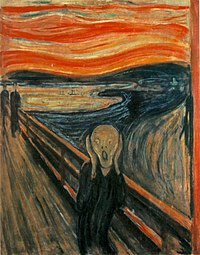
Photo from wikipedia
BACKGROUND The burden of mental health disorders is high, especially in developing countries. We assessed the prevalence of depressive and anxiety symptoms and their relationship with life-threatening events, tobacco dependence,… Click to show full abstract
BACKGROUND The burden of mental health disorders is high, especially in developing countries. We assessed the prevalence of depressive and anxiety symptoms and their relationship with life-threatening events, tobacco dependence, and hazardous alcohol drinking in the Brazilian Amazon. METHODS Cross-sectional population-based study conducted in Manaus in 2019 with adults selected by probabilistic sampling. Depressive symptoms were measured by the PHQ-9 instrument (cut-off ≥9) and anxiety symptoms by the GAD-7 scale (cut-off ≥10). Prevalence ratios (PRs) of depressive and anxiety symptoms were calculated by Poisson regression with robust variance with 95% confidence intervals (CI) following a hierarchical model. Partial least squares structural equation modeling was used to investigate the relationship between the outcomes and risk behaviors. RESULTS Out of the 2,321 participants, 24.3% (95%CI 22.2-26.5%) had depressive and 21.6% (95%CI 19.6-23.7%) had anxiety symptoms. Depressive symptoms were associated with women (PR=1.32; 95%CI1.08-1.61), lower social class (PR=1.59; 95%CI1.11-2.27), life-threatening events (PR=2.66; 95%CI2.00-3.54), tobacco dependence (PR=1.84; 95%CI1.37-2.47), worse health statuses (p<0.001), and chronic diseases (PR=1.63; 95%CI1.33-2.00), but were lower in older adults (p=0.014). Anxiety symptoms were associated with women (PR=1.74; 95%CI1.42-2.14), lower educational levels (PR=2.19; 95%CI1.38-3.47), evangelical individuals (PR=1.28; 95%CI1.05-1.57), having no religion (PR=1.72; 95%CI1.24-2.38), life-threatening events (PR=3.26; 95%CI2.41-4.41), tobacco dependence (PR=1.53; 95%CI1.09-2.16), worse health statuses (p<0.001), and chronic diseases (PR=1.77; 95%CI1.40-2.25). Depressive symptoms, anxiety symptoms, and life-threatening events were directly correlated with one another, while tobacco dependence and hazardous alcohol drinking were significantly intercorrelated (p<0.05). LIMITATIONS Cross-sectional design limits the assessment of causality. Recall bias was possible as responses were self-reported. GAD-7 scale was not validated in the Brazilian population. CONCLUSION Nearly a quarter of the population had depressive symptoms and one-fifth presented anxiety symptoms, which were associated with socioeconomic, behavioral, and health-related factors. Implementation of social well-being policies is required to minimize the burden of mental health disorders in the Amazonian population.
Journal Title: Journal of affective disorders
Year Published: 2021
Link to full text (if available)
Share on Social Media: Sign Up to like & get
recommendations!